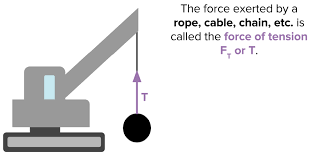
Tension in Physics
Tension is a pulling force transmitted axially by a rope, string, chain, or similar object. It’s a force that acts along the length of the object, stretching or pulling it apart. In essence, tension is the opposite of compression.
Examples of Tension:
- A Hanging Object:
- When you hang a weight from a rope, the rope experiences tension. The weight pulls downward, and the rope pulls upward to support it. The tension in the rope is equal to the weight of the object.
- Tug-of-War:
- In a tug-of-war, both teams pull on the rope with equal force. The rope experiences tension as it’s stretched between the two teams. The tension in the rope is equal to the force exerted by either team.
- A Suspended Bridge:
- The cables of a suspension bridge experience tension as they support the weight of the bridge and the traffic on it. The tension in the cables is distributed throughout the structure, ensuring its stability.
- A Guitar String:
- When you pluck a guitar string, it vibrates. The tension in the string is what allows it to vibrate and produce sound. The tighter the string, the higher the pitch of the sound.
Key Points to Remember: - Tension is a pulling force, not a pushing force.
- Tension acts along the length of an object.
- The tension in a rope or string can vary depending on the weight it’s supporting or the forces acting on it.
- Tension is a crucial concept in many areas of physics, including mechanics, statics, and dynamics.
Visual Representation:
By understanding tension, we can analyze and solve various problems involving forces and motion.






